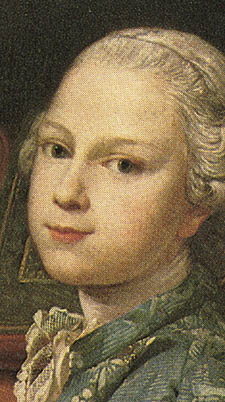
Mozart's Images Imagined
![]()
"Of no other famous man are there so many portraits
which bear no resemblance to his actual appearance as of Mozart . Of no
man does a doting posterity have so generally false a picture of him."
—Arthur Schuring, Mozart Lover
The inauthentic portraits of Mozart are of three varieties. First are the authentic, contemporary portraits of other people which someone later claimed to be of Mozart. The most commonly reproduced of these misattributions is Thaddäus Helbling’s oil painting of Mozart's childhood friend, the young Count Karl Firmian. There are numerous others, many of which have absolutely nothing to do with Mozart. Second, there are carefully made forgeries, which make some claim to have an authentic connection to Mozart. Sasso only had to claim his etching was a copy of a lost portrait in order to gain credibility. Third, there are those that amount purely to artists’ fantasies about Mozart: Mozart being presented to the Empress Maria Theresa, Mozart as a boy performing on the organ, Mozart on his deathbed, and on and on. These are inspired by common myths about Mozart’s identity and in turn create new ones. Portraits such as The Young Mozart at the Organ of the Franciscan Church in Ybbs have transformed and idealized his image beyond recognition, crossing the line from art to kitsch. Search the web for Mozart Portraits and you will find more inauthentic than authentic ones; they endure because they show us something we want to see, confirming our fantasies.

Copyright
© 2002 Division of Rare & Manuscript
Collections
2B Carl A. Kroch Library, Cornell University, Ithaca, NY, 14853
Phone Number: (607) 255-3530. Fax Number: (607) 255-9524
For
reference questions, send mail to:
rareref@cornell.edu
If you have questions or comments about the site, send mail to: webmaster.